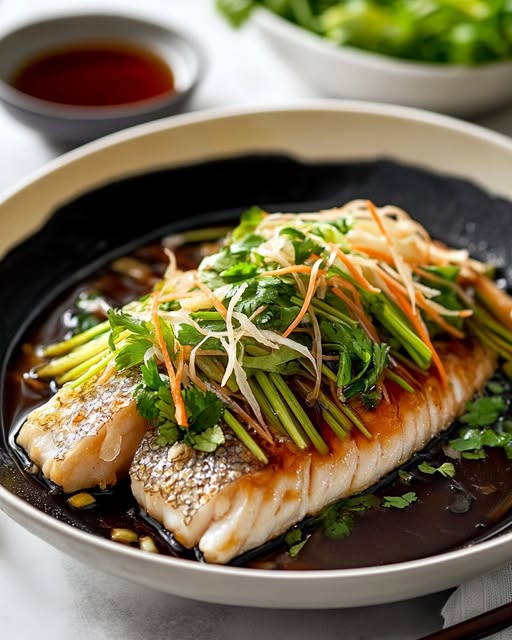Discover the Magic of Steamed Ginger Fish
Picture this: a cozy dinner table, the aroma of ginger and soy sauce wafting through the air, and a plate of tender, perfectly cooked fish waiting to be devoured. That’s what happened when I first made **Steamed Ginger Fish** for my family. It was love at first bite! This dish is simple yet packed with flavor, and it feels like a warm hug on a plate. Whether you’re a seasoned cook or a beginner, this recipe will win hearts.
A Little History Behind Steamed Ginger Fish
Steamed Ginger Fish is a classic in Chinese cuisine, often served during family gatherings and celebrations. The combination of ginger, soy sauce, and fresh aromatics creates a harmony of flavors that symbolizes balance—an important principle in Chinese cooking. Traditionally, this dish is prepared with white fish like cod or sea bass. Over time, home cooks have added their own twists, but the heart of the recipe remains the same: wholesome ingredients and gentle steam cooking.
I remember trying this dish at a friend’s house years ago. Her grandma served it with pride, explaining how steaming preserves the fish’s natural juices while infusing it with the fragrant spices. I knew I had to recreate it at home!
Why You’ll Fall in Love with Steamed Ginger Fish
If you’re looking for a dish that’s quick, healthy, and bursting with flavor, this is it. The ginger adds a zesty kick, while the soy sauce brings a savory umami touch. Plus, the vibrant colors of the garnishes—green scallions, orange carrots, and white onions—make it a feast for the eyes. Best of all? It only takes 30 minutes from start to finish. Who wouldn’t want a restaurant-quality meal ready in no time?
Perfect Occasions to Serve Steamed Ginger Fish
This dish is versatile enough for any occasion. Serve it on a weeknight when you need something easy yet satisfying. It’s also perfect for dinner parties or special events like Lunar New Year celebrations. Pair it with steamed rice, and you’ve got a complete meal that will impress your guests without breaking a sweat.
Ingredients You’ll Need
- For the fish:
- 340-400g of white fish fillet with skin (cod or sea bass works well)
- 2 teaspoons sesame oil
- 1/8 teaspoon salt
- 1/8 teaspoon black pepper
- 4cm piece of ginger, julienned
- 4-5 scallions, cut into short julienne strips
- 1 small onion, thinly sliced
- Half a medium carrot, julienned
- For the sauce:
- 1 tablespoon olive oil
- 2 small shallots, chopped (optional)
- 2-3 garlic cloves, minced
- 1/2 teaspoon minced ginger
- 1 1/2 to 2 tablespoons soy sauce
- 1/8 teaspoon salt (optional, to taste)
- 1/8 teaspoon black pepper
Substitution Options
- Use salmon instead of white fish if you prefer richer flavors.
- Swap sesame oil with vegetable oil if needed.
- If you don’t have scallions, try using chives or green onions.
- Replace soy sauce with tamari for a gluten-free option.
Step 1: Prepare the Fish
Start by placing your fish fillet on a shallow plate suitable for steaming. Drizzle it generously with sesame oil, then sprinkle with salt and pepper. Gently rub these seasonings onto the fish so every inch gets coated. Let it sit while you prep the other ingredients. Pro tip: Using sesame oil not only seasons the fish but also gives it a nutty aroma that pairs beautifully with ginger.
Step 2: Chop Your Aromatics
Grab your knife and cutting board—it’s time to chop! Peel and julienne the ginger, slice the onions, and cut the carrots into thin matchsticks. For the sauce, finely mince the garlic and shallots. These colorful veggies will add texture and layers of flavor to the dish. Imagine the freshness of ginger mingling with the sweetness of carrots—it’s pure magic!
Step 3: Make the Sauce
Heat olive oil in a small pan over medium heat. Add the minced garlic and shallots, letting them sizzle until fragrant. Stir in the ginger, and cook briefly before pouring in the soy sauce. Season with a pinch of salt and pepper, then let the mixture simmer for a few seconds. Transfer the sauce to a bowl and set aside. Pro tip: Taste the sauce as you go—you can always adjust the seasoning to suit your palate.
Step 4: Steam the Fish
Arrange the julienned ginger, onions, and carrots on top of the fish. Cover the plate loosely with aluminum foil and place it in your steamer. Let the fish steam for 8-9 minutes. The steam will gently cook the fish, locking in its moisture and infusing it with the aromatic toppings. You’ll know it’s almost done when the kitchen smells amazing!
Step 5: Finish and Garnish
Remove the foil and pour the prepared sauce evenly over the fish. Top with the scallion julienne for a pop of color. Return the plate to the steamer uncovered and let it cook for another 4-6 minutes. The final step ensures the flavors meld together beautifully. Chef’s tip: Garnish with fresh cilantro leaves just before serving for an extra touch of elegance.
Timing Breakdown
- Preparation Time: 15 minutes
- Cooking Time: 15 minutes
- Total Time: 30 minutes
- Servings: 2 people
Chef’s Secret
To elevate your Steamed Ginger Fish, drizzle a little hot oil over the finished dish right before serving. The heat releases the essential oils in the scallions, creating an irresistible aroma.
An Interesting Tidbit About Soy Sauce
Did you know that soy sauce has been around for over 2,500 years? Originating in China, it’s one of the oldest condiments in the world. Its rich history makes it a staple in many Asian cuisines, including this recipe.
Necessary Equipment
- Steamer basket or pot with a steaming rack
- Shallow heatproof plate
- Small saucepan
- Knife and cutting board
Storage Tips
If you happen to have leftovers (though I doubt you will!), store them properly. Place the cooled fish in an airtight container and refrigerate within two hours of cooking. It should stay fresh for up to two days. Reheat gently in the microwave or on the stovetop to retain its texture.
Avoid freezing Steamed Ginger Fish, as the delicate flesh may become mushy upon thawing. Instead, freeze uncooked portions of fish separately and prepare them later.
Always check for any off smells or discoloration before consuming stored food. Better safe than sorry!
Tips and Advice
- Choose the freshest fish available for the best results.
- Don’t overcrowd the steamer; leave space for steam to circulate evenly.
- Adjust the amount of ginger based on your preference for spiciness.
Presentation Ideas
- Serve the fish on a bed of fluffy jasmine rice.
- Garnish with red chili slices for a bold contrast.
- Use a decorative plate to enhance visual appeal.
Healthier Alternatives
Here are six variations to make this dish even healthier:
- Baked Version: Bake the fish in the oven at 375°F (190°C) for 15-20 minutes for a low-maintenance option.
- Low-Sodium Option: Use reduced-sodium soy sauce to cut back on salt.
- Vegan Twist: Replace the fish with tofu or tempeh for a plant-based alternative.
- Spicy Kick: Add a dash of chili oil to the sauce for heat lovers.
- Herbaceous Touch: Mix fresh herbs like parsley or dill into the sauce.
- Lemon Zest Addition: Sprinkle lemon zest over the fish for a citrusy note.
Mistake 1: Overcooking the Fish
Overcooked fish becomes dry and loses its delicate texture. To avoid this, keep an eye on the timer and test the fish’s doneness by flaking it gently with a fork. Pro tip: The fish is ready when it turns opaque and flakes easily.
Mistake 2: Skipping the Foil Step
Some folks skip covering the fish with foil during the initial steaming phase, which can lead to uneven cooking. Always cover the plate to trap the steam and ensure the fish cooks evenly.
Mistake 3: Using Old or Low-Quality Soy Sauce
Using stale or low-grade soy sauce can ruin the dish’s flavor profile. Invest in a good-quality bottle—it truly makes a difference!
Mistake 4: Not Prepping Ingredients Ahead
Steaming is a fast process, so having everything prepped beforehand is crucial. Mis en place (having all ingredients ready) prevents last-minute scrambling.
Frequently Asked Questions
Can I use frozen fish for this recipe?
Yes, but thaw it completely before cooking. Pat it dry with paper towels to remove excess moisture, ensuring better seasoning absorption.
What type of fish works best?
White fish like cod, sea bass, or snapper are ideal due to their mild flavor and firm texture. Avoid oily fish like mackerel.
Do I need a bamboo steamer?
No, a metal steamer or even a pot with a steaming rack works fine. Bamboo steamers add authenticity but aren’t mandatory.
How do I prevent the fish from sticking to the plate?
Lightly grease the plate with a bit of oil or line it with parchment paper for easy removal.
Can I make the sauce ahead of time?
Absolutely! Store it in the fridge for up to three days and reheat gently before using.
Is this dish kid-friendly?
Yes! Kids love the mild flavors. You can omit the chili if they’re sensitive to spice.
What sides pair well with Steamed Ginger Fish?
Steamed broccoli, bok choy, or stir-fried vegetables complement the dish beautifully.
Can I double the recipe?
Of course! Just ensure your steamer is large enough to accommodate multiple plates.
Why does my fish smell fishy?
Fresh fish shouldn’t have a strong odor. If it does, it might not be fresh. Always buy from reputable sources.
How can I tell if the fish is fully cooked?
The fish should be opaque and flake easily with a fork. If it still looks translucent, give it another minute or two.
Final Thoughts
Steamed Ginger Fish is more than just a recipe—it’s an experience. With its vibrant flavors, ease of preparation, and health benefits, it’s a dish worth adding to your repertoire. So grab your ingredients, fire up your steamer, and treat yourself to a meal that’s both comforting and sophisticated. Bon appétit! 🍴

Steamed Ginger Fish
Ingredients
Equipment
Method
- Place the fish fillet on a shallow plate suitable for steaming and drizzle with sesame oil, then sprinkle with salt and pepper.
- Peel and julienne the ginger, slice the onions, and cut the carrots into thin matchsticks; finely mince the garlic and optional shallots for the sauce.
- Heat olive oil in a small pan over medium heat, add minced garlic and shallots, then stir in ginger and soy sauce, seasoning with salt and pepper, and simmer briefly.
- Arrange julienned ginger, onions, and carrots on top of the fish and cover loosely with aluminum foil; steam for 8-9 minutes.
- Remove the foil, pour the sauce evenly over the fish, top with scallion julienne, then steam uncovered for another 4-6 minutes.
